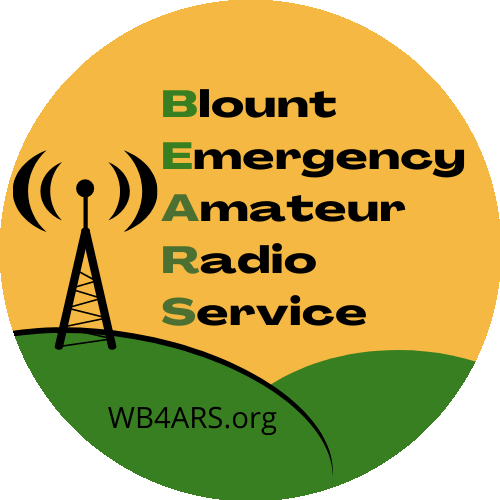Blount Emergency Amateur Radio Service
Our mission is to provide communications assistance by trained volunteer operators to public safety and other community agencies and organizations in the Blount County area during emergencies and other times of need.
Partnerships


ARES
Amateur Radio Emergency Service® (ARES) consists of licensed amateurs who have voluntarily registered their qualifications and equipment, with their local ARES leadership, for communications duty in the public service when disaster strikes.
Learn more
Blount County ARES
The Blount County ARES group is the primary group supported by BEARS.
Join their Team AppLatest News

Discover the AREDN Project: Enhancing Emergency Communications for Amateur Radio Operators
In our meeting this past Tuesday, the topic of the Amateur Radio Emergency Data Network (AREDN) project project was discussed.
This innovative initiative is designed to provide robust, high-speed data networks using amateur radio frequencies in the 2.4GHz, 3.4GHz and 5.8GHz ranges.
What is AREDN?
AREDN leverages commercial off-the-shelf wireless networking equipment, repurposing it to operate on amateur radio frequencies. This enables the creation of resilient, high-speed, long-range mesh networks that can be deployed quickly in emergency situations. These networks support a variety of applications, including:
- Voice Over IP (VoIP) Communications: Facilitate clear, reliable voice communications even when traditional infrastructure is down.
- Data Transfer: Share critical information, including images and documents, rapidly across the network.
- Internet Access: Provide internet connectivity in areas where it may be unavailable during disasters.
- By utilizing the flexibility and power of mesh networking, AREDN ensures that communication links remain operational even if some nodes in the network are compromised.
Learn More About AREDN
To dive deeper into the AREDN project we recommend visiting the following resources:
- AREDN Official Website: arednmesh.org
This site provides comprehensive information about the project, including detailed guides on setting up and configuring your own AREDN nodes.
- AREDN Knoxville: arednknoxville.com
This local site offers specific insights, news, and updates about AREDN activities and deployments in our community.

Trailer Signage Complete
Blount County ARES Members,
We are thrilled to announce that the final touches have been added to our ARES trailer! On Tuesday evening, just before our meeting, the last of the signage was applied. This milestone marks the completion of our trailer’s exterior, and we couldn’t be happier with the results.
If you haven’t had the chance to see our newly finished trailer yet, you’re in luck. We will be showcasing it this weekend at the Middlesettlements UMC Field of Dreams event. This is a great opportunity to see the trailer in action and appreciate the hard work that has gone into making it a valuable asset for our community.
We want to extend our heartfelt thanks to everyone who contributed to this project. Your dedication and effort have truly made a difference, and we couldn’t have done it without your support.
For more details about the Field of Dreams event, please visit [Middlesettlements UMC Field of Dreams](https://www.middlesettlements.com/field-of-dreams). We hope to see you there!
Thank you once again for all your hard work and commitment to making our ARES trailer the best it can be.

Bob Heil, K9EID, Silent Key
The man who defined the sound of live rock ‘n’ roll music and brought audio engineering principals into mainstream amateur radio use, Dr. Bob Heil, K9EID, has passed away at the age of 83.
https://www.arrl.org/news/view/bob-heil-k9eid-silent-key

Volunteers Needed - 2024 Strawberry Plains Half Marathon
It is time again to step up and help with the Strawberry Plains Half Marathon and 10K.
The event is schedule for Saturday February 17, 2024. Race starts at 8:00 AM; volunteers should be in place by 7:30 AM.
If you are interesting in volunteering, send Lloyd Pitney an email with your:
Name:
Phone Number:
Call Sign:
Location you may want:
If you plan on working with someone, please let Lloyd know their information also.
Lloyd Pitney: [email protected]

Happy New Year!
As we welcome in 2024, we want to look ahead to our upcoming events. These events offer a chance for us to come together, share experiences, and, most importantly, play radio!
Mark your calendars for these fantastic opportunities to make a positive difference while having a great time:
- 01/27 Winter Field Day 2024
- 02/17 Strawberry Plains Half Marathon 2024
- 03/16 Sevierville Hamfest 2024
- 04/07 Knoxville Marathon 2024
- 06/01 Cherohala Challenge 2024
- 06/15 Knoxville Hamfest 2024
If you are aware of other events that should be added to the calendar, please share that information with me at [email protected].
May this New Year bring you abundant happiness, good health, and the fulfillment that comes from making a positive impact on the lives of others. Here’s to another year of making a difference together!

Annual Christmas Dinner This Wednesday
We will be gathering this Wednesday at the Windy City Grill for our annual Christmas dinner. Spouses/significant others are welcome – this is a Dutch treat (each person pays their own expenses) event.
NOTE we will not be having a regular monthly meeting in December.
We look forward to seeing everyone there!
https://bcares.teamapp.com/events/23215514-annual-christmas-dinner?detail=v1&_expiresat=1706745599
Upcoming Events
1 AUG
9:00pm - 9:15pm, 1 Aug

Blount ECS Weekly Net
This is our weekly, Thursday night net. Please check-in if you are available. Surrounding counties are welcome to check-in so we can confirm our cross-county communications.
If the net is not called by 9:05 PM, assume that net control is not available and call the net.
The Blount County ARES net normally meets on Thursday at 9:00 PM using 146.625 Mhz, tone 118.8 Hz, offset -0.600 Mhz as the primary frequency. Alternate frequencies include 146.655, offset -600, tone 100 Hz and 445.900 Mhz (simplex).
Anytime there is severe weather or an area emergency you should monitor our primary frequencies and the Blount Memorial Hospital simplex frequency 147.420 for help requests.
8 AUG
9:00pm - 9:15pm, 8 Aug

Blount ECS Weekly Net
This is our weekly, Thursday night net. Please check-in if you are available. Surrounding counties are welcome to check-in so we can confirm our cross-county communications.
If the net is not called by 9:05 PM, assume that net control is not available and call the net.
The Blount County ARES net normally meets on Thursday at 9:00 PM using 146.625 Mhz, tone 118.8 Hz, offset -0.600 Mhz as the primary frequency. Alternate frequencies include 146.655, offset -600, tone 100 Hz and 445.900 Mhz (simplex).
Anytime there is severe weather or an area emergency you should monitor our primary frequencies and the Blount Memorial Hospital simplex frequency 147.420 for help requests.
15 AUG
9:00pm - 9:15pm, 15 Aug

Blount ECS Weekly Net
This is our weekly, Thursday night net. Please check-in if you are available. Surrounding counties are welcome to check-in so we can confirm our cross-county communications.
If the net is not called by 9:05 PM, assume that net control is not available and call the net.
The Blount County ARES net normally meets on Thursday at 9:00 PM using 146.625 Mhz, tone 118.8 Hz, offset -0.600 Mhz as the primary frequency. Alternate frequencies include 146.655, offset -600, tone 100 Hz and 445.900 Mhz (simplex).
Anytime there is severe weather or an area emergency you should monitor our primary frequencies and the Blount Memorial Hospital simplex frequency 147.420 for help requests.

